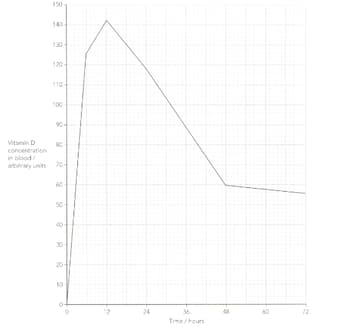In an investigation into the absorption of vitamin D from the alimentary canal, a volunteer ate a measured quantity of vitamin D on a piece of roast. Blood samples were then taken from him at intervals over a period of 72 hours, and the concentration of vitamin D in each blood sample was measured.
The results are shown in the graph in figure 7.2.

Describe the changes in the concentration of vitamin D in the blood over the 72-hour period.


Important Questions on Human Nutrition
Vitamin D is soluble in fat, but insoluble in water. It is present in the fat component of foods that eat.
Use this information to suggest how bile helps to absorb vitamin D from food.
Vitamin D is soluble in fat, but insoluble in water. It is present in the fat component of foods that eat.
Suggest into which part of the villi is absorbed. Explain your suggestion.
